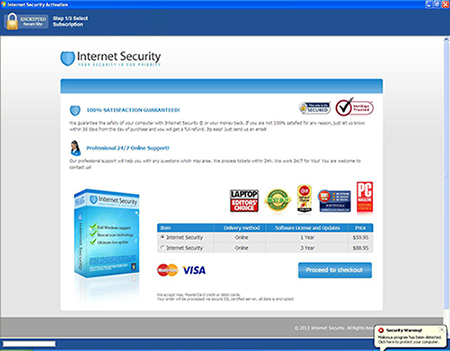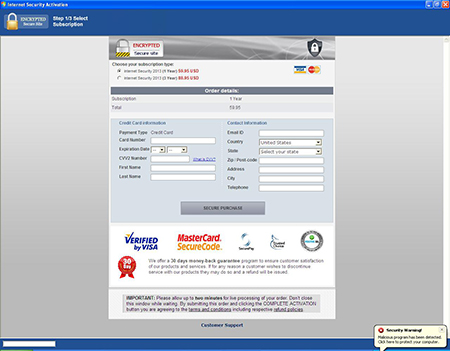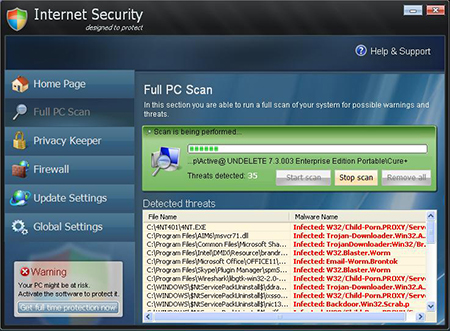TROJ_FAKEAV.ID
Mal/FakeAV-JO(Sophos), a variant of Win32/Kryptik.BCGZ trojan(Eset)
Windows 2000, Windows Server 2003, Windows XP (32-bit, 64-bit), Windows Vista (32-bit, 64-bit), Windows 7 (32-bit, 64-bit)


Threat Type: Trojan
Destructiveness: No
Encrypted: Yes
In the wild: Yes
OVERVIEW
Downloaded from the Internet, Dropped by other malware
This Trojan arrives on a system as a file dropped by other malware or as a file downloaded unknowingly by users when visiting malicious sites.
It does not have any propagation routine.
It does not have any backdoor routine.
It does not have any downloading capability.
When users agree to buy the software, it connects to a certain URL. It displays a window where users can purchase this fake antivirus program.
TECHNICAL DETAILS
843,264 bytes
EXE
Yes
29 May 2013
Connects to URLs/IPs, Terminates processes, Displays message/message boxes
Arrival Details
This Trojan arrives on a system as a file dropped by other malware or as a file downloaded unknowingly by users when visiting malicious sites.
Autostart Technique
This Trojan adds the following registry entries to enable its automatic execution at every system startup:
HKEY_CURRENT_USER\Software\Microsoft\
Windows\CurrentVersion\Run
Internet Security = "{Malware Path and File Name}.exe"
Other System Modifications
This Trojan adds the following registry keys:
HKEY_CURRENT_USER\Software\{random value}
It adds the following registry entries:
HKEY_CURRENT_USER\Software\{random value}
FRun = "0"
HKEY_CURRENT_USER\Software\{random value}
O`ld = "Houdsodu!Rdbtshux"
HKEY_CURRENT_USER\Software\{random value}
Q`ui = "{random}"
Propagation
This Trojan does not have any propagation routine.
Backdoor Routine
This Trojan does not have any backdoor routine.
Download Routine
This Trojan does not have any downloading capability.
Rogue Antivirus Routine
This Trojan displays the following fake alerts:
When users agree to buy the software, it connects to the following URL to continue the purchase:
- http://{BLOCKED}rtal360.com/404.php?id=105
- http://{BLOCKED}check24.com/activate/activae.php
- http://{BLOCKED}einternational.com/support.php
- http://{BLOCKED}yserviceauto.com/buynow.php?bid=105
- http://{BLOCKED}yhelpsupport.com/open.php
- http://{BLOCKED}yserviceauto.com/support.html
The following window is displayed for users to purchase the fake antivirus program:
It displays the following window and pretends to scan the system:
NOTES:
It does not have rootkit capabilities.
It does not exploit any vulnerability.
SOLUTION
9.300
9.948.04
29 May 2013
9.949.00
30 May 2013
Step 1
Before doing any scans, Windows XP, Windows Vista, and Windows 7 users must disable System Restore to allow full scanning of their computers.
Step 2
Restart in Safe Mode
Step 3
Delete this registry key
Important: Editing the Windows Registry incorrectly can lead to irreversible system malfunction. Please do this step only if you know how or you can ask assistance from your system administrator. Else, check this Microsoft article first before modifying your computer's registry.
- In HKEY_CURRENT_USER\Software
- {random value}
- {random value}
Step 4
Delete this registry value
Important: Editing the Windows Registry incorrectly can lead to irreversible system malfunction. Please do this step only if you know how or you can ask assistance from your system administrator. Else, check this Microsoft article first before modifying your computer's registry.
- In HKEY_CURRENT_USER\Software\Microsoft\Windows\CurrentVersion\Run
- Internet Security = "{Malware Path and File Name}.exe"
- Internet Security = "{Malware Path and File Name}.exe"
Step 5
Restart in normal mode and scan your computer with your Trend Micro product for files detected as TROJ_FAKEAV.ID. If the detected files have already been cleaned, deleted, or quarantined by your Trend Micro product, no further step is required. You may opt to simply delete the quarantined files. Please check this Knowledge Base page for more information.
Did this description help? Tell us how we did.









